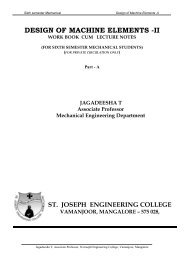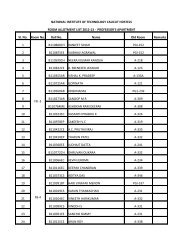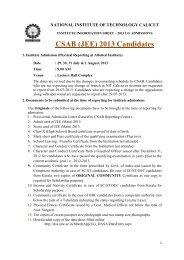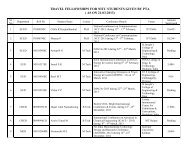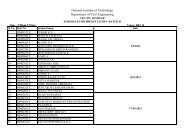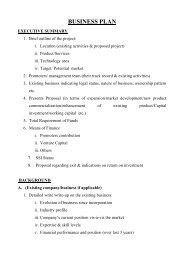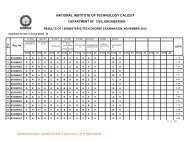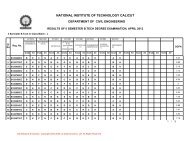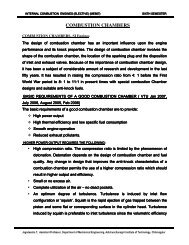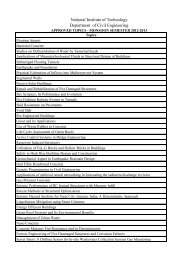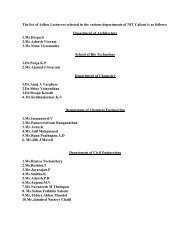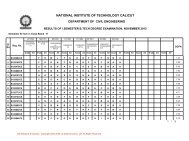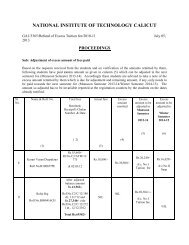You also want an ePaper? Increase the reach of your titles
YUMPU automatically turns print PDFs into web optimized ePapers that Google loves.
DEFINITIONA fixture is a device used for holding workpiece duringmachining operations.Why use a fixture? Ordinary work holders are uneconomical when number ofparts are more. Used for holding and locating workpiece
Design Principles Decide on locating points and clamping. For mating parts , use corresponding locating pointsto ensure proper alignment. Try to use 3-2-1 location , with 3 to largest surface. Locating points should be visible so that operator cansee if they are clean and replace it when needed. Provide clamps that are quick acting , easy to useand economical Clamps should be integral part of device.
Avoid complicated clamping arrangements can wearout or malfunction. Locate clamps opposite to locators to avoiddeflection during machining and springback . Take the thrusting forces on locators and not onclamps. Make the <strong>fixtures</strong> foolproof. Consistent with strength and rigidity ,make the workholder as light as possible.
Provide ample room for chip clearance and removal Provide accessibility for cleaning. Provide path for cutting fluid which may carry offchips. Provide four feet on all movable work holders. Provide hold-down lugs for all fixed work holder. Provide keys to align <strong>fixtures</strong> on machine table. Safety of operators should be ensured.
Types of <strong>fixtures</strong> Milling <strong>fixtures</strong> Planning <strong>fixtures</strong> Lathe <strong>fixtures</strong> Boring <strong>fixtures</strong> Turning <strong>fixtures</strong> Broaching <strong>fixtures</strong>
Types of <strong>fixtures</strong> Grinding <strong>fixtures</strong> Shaping <strong>fixtures</strong> Assembly <strong>fixtures</strong> Inspections <strong>fixtures</strong> Welding <strong>fixtures</strong> Modular <strong>fixtures</strong>
LATHE FIXTURESMany parts such as casting and forging cannot readily bemounted by any of the standard methods. There, it isnecessary to manufacture special work-holding <strong>fixtures</strong>.
The basic principles of <strong>fixtures</strong>design apply to the <strong>lathe</strong> <strong>fixtures</strong>.However, there are additionalconsiderations that apply to the<strong>lathe</strong> <strong>fixtures</strong>, since the fixtureand the work piece revolve.They are as follows..
1. Clamps and other holding devices should be designedin such a way that they will not be loosened bycentrifugal force.2. The work piece should be gripped on its largestdiameter. And whenever possible, the grippingdiameter should be larger than the diameter to beingmachined.3. Projection and sharp corners should be avoided.4. The <strong>fixtures</strong> should be well balanced. Irregular shapedworkpieces may have to counterweighed to preventvibration.5. The <strong>fixtures</strong> should be as light as possible as it isrotating.6. This section of the work pieces may require support toresist the pressure of the <strong>lathe</strong> tool.
Rocking jaw chuckUsing a set of rocking jaw chucks helps ensure a securegrip on the part regardless of the surface roughness inthe gripping area. Two of the three jaws are solid withthe third rocking.
Solid jaws Similar to rocking jaws but cost less than rockers tomake Suitable for use on two or threejaw chucks. Two of the jaws on three jaw chucks should havegripping areas on each end. Special top jaws may be designed for better fit to thegripping diameter of the work piece.
Face plate fixture It is fastened to a standard clamping and locating devices. It rotates around the <strong>lathe</strong> axis. It is usually located on the face plate by means of twodowel pins and secured by cap screws inserted throughthe face plate by means of two pins in ti tapped holes inthe fixture or by T bolts inserted in to T-slots in the faceplate.
Magnetic <strong>lathe</strong> chuck It has the advantage of being able to hold thin gold partsduring turning and boring operations without distortion. Only suitable for light turning operations.
Mandrel This is used for holding hollow work pieces betweencentres. Some of the common types of mandrel used in <strong>lathe</strong>work are discussed here
Solid mandrel Also known as plain mandrel. Most commonly used in shops. Body has a slight taper. Taper is given for gripping of work piece. Difference in dia will be 1 to 2 mm per 100 mm length.
Gang mandrel It has fined collar at one end other end has a threadedportion.at this threaded end there is a movable collar. A set of hollow work pieces can be held between thetwo collars.
Expanding mandrelsA bush is mounted over this arbor. This bush has a tapered hole and acylindrical out surface.Three longitudinal slots are cut on the bush.By this construction it is possible to expand the split bushing within a limit.Therefore various work pieces of different diameter holes can be held in thisexpanding mandrel.
Cone mandrel It has two conical ends.one end has a solid cone theother end has got thread. At threaded end there is asliding cone.this sliding cone can adjusted by a nut. This is used for holding workpieces of different holediameters.



